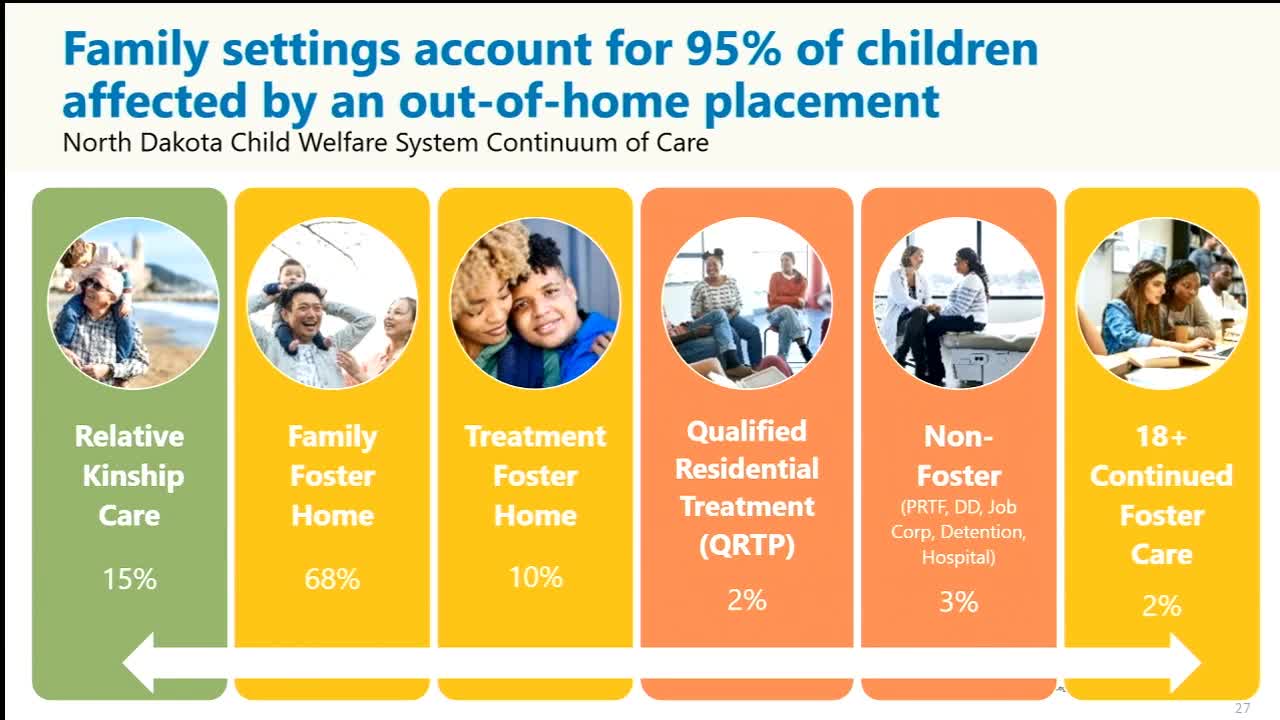North Dakota reports decline in foster care placements under new Family First initiative
March 25, 2025 | Appropriations - Human Resources Division, Senate, Legislative, North Dakota
This article was created by AI summarizing key points discussed. AI makes mistakes, so for full details and context, please refer to the video of the full meeting. Please report any errors so we can fix them. Report an error »

In a recent meeting of the North Dakota Senate Appropriations Committee, the focus turned to the pressing issues surrounding the state's foster care system, particularly through the lens of a case study involving a young girl named Taylor. The discussion highlighted the challenges faced by children in foster care, the importance of family connections, and the evolving landscape of child welfare services in North Dakota.
Taylor, who has been in foster care for 15 months, is currently living with a foster family under the supervision of a human service zone. Her situation is concerning; she has exhibited risky behaviors, including substance use and running away, and has had multiple interactions with law enforcement. The committee members expressed deep concern over her prolonged stay in foster care, which exceeds the federal guideline of 12 months for reunification efforts.
The conversation shifted to the importance of family connections in the foster care system. Questions arose about Taylor's biological family and the possibility of placing her with relatives. The committee noted that a thorough relative search had been conducted, resulting in the identification of an aunt in North Dakota who could potentially provide a stable home for Taylor. This move could lead to a guardianship arrangement, allowing Taylor to transition out of the foster care system while still receiving necessary support services.
The meeting also addressed the broader context of North Dakota's foster care system, which has seen a significant reduction in the number of children in care. The committee discussed the implementation of the Family First Prevention Services Act, which aims to keep families together and reduce reliance on congregate care facilities. This shift has led to a decrease in the number of residential childcare facilities, with a focus on ensuring that children receive care in more family-like settings.
As the committee reviewed the data, it became clear that North Dakota had previously ranked among the top states for children placed in congregate care—a distinction that officials were eager to change. The introduction of new standards and oversight under the Family First Act has been a pivotal step in reshaping the state's approach to child welfare.
In conclusion, the discussions during the meeting underscored the urgent need for reform in the foster care system, emphasizing the importance of family connections and the ongoing efforts to provide better outcomes for children like Taylor. As North Dakota continues to navigate these challenges, the commitment to improving the lives of its most vulnerable residents remains a top priority for lawmakers and child welfare advocates alike.
Taylor, who has been in foster care for 15 months, is currently living with a foster family under the supervision of a human service zone. Her situation is concerning; she has exhibited risky behaviors, including substance use and running away, and has had multiple interactions with law enforcement. The committee members expressed deep concern over her prolonged stay in foster care, which exceeds the federal guideline of 12 months for reunification efforts.
The conversation shifted to the importance of family connections in the foster care system. Questions arose about Taylor's biological family and the possibility of placing her with relatives. The committee noted that a thorough relative search had been conducted, resulting in the identification of an aunt in North Dakota who could potentially provide a stable home for Taylor. This move could lead to a guardianship arrangement, allowing Taylor to transition out of the foster care system while still receiving necessary support services.
The meeting also addressed the broader context of North Dakota's foster care system, which has seen a significant reduction in the number of children in care. The committee discussed the implementation of the Family First Prevention Services Act, which aims to keep families together and reduce reliance on congregate care facilities. This shift has led to a decrease in the number of residential childcare facilities, with a focus on ensuring that children receive care in more family-like settings.
As the committee reviewed the data, it became clear that North Dakota had previously ranked among the top states for children placed in congregate care—a distinction that officials were eager to change. The introduction of new standards and oversight under the Family First Act has been a pivotal step in reshaping the state's approach to child welfare.
In conclusion, the discussions during the meeting underscored the urgent need for reform in the foster care system, emphasizing the importance of family connections and the ongoing efforts to provide better outcomes for children like Taylor. As North Dakota continues to navigate these challenges, the commitment to improving the lives of its most vulnerable residents remains a top priority for lawmakers and child welfare advocates alike.
View full meeting
This article is based on a recent meeting—watch the full video and explore the complete transcript for deeper insights into the discussion.
View full meeting
